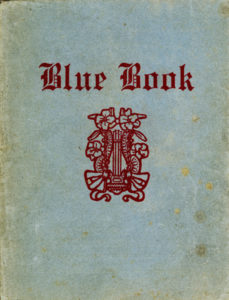New Orleans Blue Books
Blue Books is the common name given to the various published directories of female prostitutes and houses of prostitution in Storyville, New Orleans' legally designated red-light district.

Courtesy of The Historic New Orleans Collection
Blue Book. Unidentified
Numerous listings of the elite, as well as compilations of government-related information and tourist guides are often described as “Blue Books.” In late 19th- and early 20th-century New Orleans, Blue Books referred to the various published directories of female prostitutes and houses of prostitution in the city’s legally designated red-light district. The word blue, though not always part of the title, could possibly refer to both antivice or “blue” laws and the moneyed, sporting men or “bluebloods” who frequented this district. Popularly called Storyville (for alderman Sidney Story, who successfully prepared and sponsored the legislation which established it), this district existed between 1897 and 1917. With the United States’ entry into World War I, the federal government prohibited open prostitution within five miles of any military installation, and consequently, forced the city to close Storyville.
While other cities offered occasional guides to their vice districts, these directories were produced on a semiregular basis in New Orleans. At least sixteen different issues are known, but there are probably others. The earliest Blue Book appeared around 1898 and the last around 1915. Although thousands of copies of various issues were published, few are dated or marked as numbered editions. Pocket-sized or even smaller, they list madams in bold-faced type or capital letters and include full-page advertisements for the better brothels. None of the Storyville Blue Books specifically state sexual services offered at any of the brothels, with the exception of “French” (fellatio), nor any fees for such services. By modern standards, the Blue Books were written in almost demure terms. Individual women are listed either alphabetically by surname or by street address, and are identified as “white,” “colored,” or “octoroon,” with earlier Blue Books also designating “Jewish,” or “French.”
The Blue Books were probably published within the district by Billy Struve, a former police reporter for the New Orleans Daily Item and friend of Tom Anderson, a businessman, state legislator, and unofficial “Mayor of Storyville.” Struve identifies himself as “Billy News” in the introductions to most issues. The directories were sold to men in barbershops, saloons, and railroad stations. They carried advertisements for products and services other than brothels, such as wines, liquors, cigars, glassware, crockery, restaurants, piano tuners, funeral parlors, lawyers, and “cures” for venereal diseases. Advertisements for the “French Balls” held during the carnival season indicate that Blue Books may have been issued in anticipation of increased business from visitors. In addition to these ads, several Blue Books contain photographs of the interiors of the better brothels.
